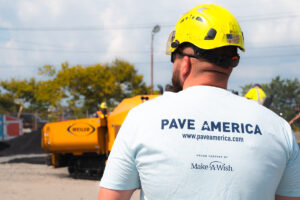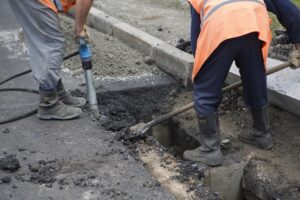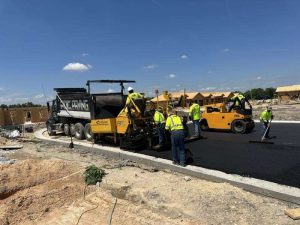 Whether you selected asphalt paving for your residential driveway or commercial parking lot, you made a wise choice. Your pavement was economical and fast to construct, boosted your curb appeal, and has the potential to provide you with many years of service. To get the most out of your new pavement, however, you should consider adding Austin asphalt sealcoating to your pavement maintenance plan. Whether you need an initial application or a reapplication, spring is a wonderful season to have your contractor sealcoat your pavement.
Whether you selected asphalt paving for your residential driveway or commercial parking lot, you made a wise choice. Your pavement was economical and fast to construct, boosted your curb appeal, and has the potential to provide you with many years of service. To get the most out of your new pavement, however, you should consider adding Austin asphalt sealcoating to your pavement maintenance plan. Whether you need an initial application or a reapplication, spring is a wonderful season to have your contractor sealcoat your pavement.
Why Choose the Springtime for Austin Asphalt Sealcoating?
Successful asphalt sealcoating in Austin requires certain weather conditions to come together on the day of the application. These conditions are interrelated, but they all have to do with the rate of evaporation. Asphalt sealcoating mixes are about 70% water, and this water needs to evaporate so that the sealcoating can dry and cure in specific manner. Here are the conditions that an asphalt sealcoating company must evaluate before starting an application.
1. What is the temperature? The ideal temperature for sealcoating parking lots and other asphalt pavements is approximately 70 degrees Fahrenheit. However, if the other conditions are acceptable, asphalt sealcoating contractors can achieve successful applications at temperatures as low as 50 degrees.
2. What is the relative humidity? The lower the humidity is, the faster evaporation can occur. This is because the higher the humidity is, the more water the air already contains, leaving less room for the water escaping from the sealcoating. Asphalt sealcoating companies prefer humidity levels below 50%, but they can successfully complete an application when the humidity is as much as 90%.
3. What is the wind velocity? The wind velocity is especially critical when the humidity is high. If there is a light breeze, it circulates the air above the sealcoating, moving away saturated air so that water can continue to escape from the sealant. At the very least, contractors prefer wind velocity of 4 mph if it is a steady breeze. However, high wind speeds can make the application more challenging, so contractors typically prefer a wind velocity of less than 12 mph when applying asphalt sealcoating in Austin.
4. How much sunlight will be available on the day of the application? Typically, when sealcoating parking lots, contractors apply a thin coat, allow it to dry, then apply a second coat. Sunlight generates heat, which helps expedite drying, but it also renews heat, which helps expedite curing. It is important to remember that drying and curing are not the same thing. Depending on the weather, Austin asphalt sealcoating may feel dry to the touch within an hour or so, but the curing process is still underway. While curing, the sealcoating forms a strong bond with the pavement, and it also creates the hard shell that protects the pavement. Asphalt sealcoating in Austin needs to be exposed to sunlight for at least four hours to complete the curing process.
Why Add Austin Asphalt Sealcoating to a Pavement Maintenance Plan?
Sealcoating parking lots, driveways, and other pavements is an economical way to protect asphalt pavements from damage and enhance their appearance at the same time.
1. Inevitably, vehicles are going to leak fluids onto your pavement, and virtually all of these fluids are petroleum distillates. The asphalt binder holding your pavement together is also a petroleum distillate. When petroleum distillates meet, they attempt to recombine in a rather destructive manner. In the case of your pavement, it is the asphalt binder that will end up being destroyed. The automotive fluids will cause the pavement to soften, then crumble. Sealcoating increases the amount of time you have to remove leaked automotive fluids before they can interact with your pavement.
2. You have probably heard that UV rays can damage your skin, but you might not know that they are extremely dangerous to your asphalt pavement. They steal your pavement’s moisture, leading to a brittle pavement that is more vulnerable to damage. The UV rays also rob your asphalt pavement of its luxurious dark color. Austin asphalt sealcoating blocks UV rays to prevent both physical and cosmetic damage. Furthermore, it can return faded pavements to their original color.
3. Every experienced asphalt sealcoating company knows that water is a powerful enemy of asphalt pavements. If water gets underneath the surface of your pavement, it can erode the foundation. Weak, unstable foundations can result in widespread damage that can be costly to repair. Sealcoating helps prevent water penetration by preventing damage that could give water an easy way to get beneath the pavement, but it also enhances the pavement’s overall waterproofing ability.
4. Sealcoating parking lots will help make your markings really stand out. The dark background offers an excellent contrast that can make your parking lot safer by increasing the visibility of your stripes and markings. Your parking lot will also be more visually appealing.
5. Sealcoating contains sand, and this improves traction. Your pavement will be safer because pedestrians will not be as likely to slip and fall, and drivers will be less likely to go into a skid. Furthermore, the fine grains of sand will settle in hairline cracks or other surface flaws, giving the pavement a more even appearance.
For superior Austin asphalt sealcoating, contact RDC Paving. We also offer asphalt crack repairs, concrete repairs, asphalt paving, asphalt repairs, parking lot striping, asphalt milling, asphalt overlays, parking lot maintenance, and asphalt driveway paving. In addition, we install concrete parking lots, concrete driveways, concrete ADA features, concrete sidewalks, concrete curbs, and concrete ramps. We have an exceptional reputation for consistently providing high-quality workmanship and extraordinary service. If you would like to request a free job quote, submit our online form, email Ryan@RDCPaving.com, or call 512-920-9155.




